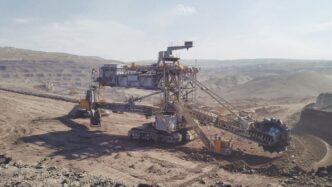Thinking about getting into crypto mining? It’s a bit like picking out a new computer, but way more specialized. You’ve got different kinds of machines, each good for something specific. Picking the right crypto mining machine is a big deal because it affects how much digital money you can actually make. Let’s break down what you need to know so you don’t end up with a fancy paperweight.
Key Takeaways
- When choosing a crypto mining machine, think about ASICs for Bitcoin and GPU rigs for other coins. FPGAs are an option if you like to tinker.
- Your machine’s hash rate and how much power it uses are super important for making money. Don’t forget about the upfront cost and how long it’ll last.
- Keep your mining gear cool! Heat is the enemy, and you’ll need good cooling and enough power to keep things running smoothly.
- Look into companies like Bitmain for your hardware. Check what other people say about them and their products before you buy.
- To make the most profit, join a mining pool, watch the market, and always keep track of your total costs, not just the price tag.
Understanding Cryptocurrency Mining Hardware Options
When you’re looking to get into crypto mining, the first big decision you’ll face is what kind of machine to use. It’s not like picking out a new phone; these things are specialized tools, and the type you choose really matters for how much you can actually make. Think of it like choosing between a sports car, a truck, and a custom-built race car – they all have their place, but they’re built for different jobs.
ASIC Miners: The Powerhouses of Bitcoin Mining
ASICs, or Application-Specific Integrated Circuits, are basically purpose-built mining machines. They’re designed to do one thing and one thing only: mine a specific cryptocurrency algorithm, usually SHA-256 for Bitcoin. Because they’re so specialized, they’re incredibly efficient and powerful for their intended task. You won’t find an ASIC miner trying to mine Ethereum; it’s just not what it’s made for. They offer the highest hash rates, which is the speed at which they can perform calculations, making them the go-to for serious Bitcoin miners. However, this power comes at a cost, both in terms of the initial investment and the fact that if the coin they mine becomes unprofitable or its algorithm changes, they can become useless.
Here’s a quick look at how some top-tier ASICs stack up:
| Miner Model | Hash Rate (TH/s) | Power Consumption (W) | Efficiency (J/TH) |
|---|---|---|---|
| Bitmain Antminer S21 | 335 | 6000 | ~17.9 |
| Whatsminer M60S | 300 | 5500 | ~18.3 |
GPU Mining Rigs: Setup and Optimization
GPU mining rigs are a bit more flexible. Instead of being built for just one algorithm, they use graphics cards (like the ones in gaming PCs) that can be programmed to mine various cryptocurrencies. This versatility is a big plus. If one coin isn’t doing well, you can often switch to another. Setting up a GPU rig involves putting together several components: the graphics cards themselves, a motherboard with enough slots, a power supply that can handle everything, and a cooling system because these cards get hot. You’ll need to pay attention to:
- Graphics Cards: The heart of the rig. More powerful cards mean higher hash rates.
- Motherboard: Needs enough PCIe slots to support all your GPUs.
- Power Supply Unit (PSU): Must be rated high enough to power all components, with some buffer.
- Cooling: Fans, open-air frames, or even more advanced solutions to keep temperatures down.
While not as powerful as ASICs for specific coins like Bitcoin, GPUs offer a good balance for mining a wider range of altcoins and are a popular choice for many miners. You can find more information on setting up these rigs on sites dedicated to Bitcoin mining.
FPGA Miners: Customizable Mining Solutions
FPGA, or Field-Programmable Gate Array, miners are kind of the middle ground. They’re more specialized than GPUs but less so than ASICs. The cool thing about FPGAs is that you can reprogram them to mine different algorithms, offering a level of customization that ASICs lack. They generally offer better efficiency than GPUs but aren’t usually as powerful as the latest ASICs. Because they can be reprogrammed, they tend to have a longer useful lifespan, as they can adapt to changes in mining algorithms. However, they are often more expensive upfront and can be harder to find compared to ASICs and GPUs. Their complexity means they’re usually favored by more experienced miners looking for that specific blend of efficiency and adaptability.
Key Considerations for Your Crypto Mining Machine
Alright, so you’re thinking about getting a crypto mining machine. That’s cool! But before you just grab the first shiny thing you see, there are a few things you really need to think about. It’s not just about buying a box and hitting ‘go’.
Hash Rate and Energy Consumption
This is probably the most important stuff to get your head around. The hash rate tells you how fast your machine can do the math needed to mine crypto. A higher hash rate generally means you’ll find more blocks and earn more coins. But here’s the catch: more power usually means more electricity used. You’ve got to balance that hash rate with how much power it’s sucking up. If your electricity bill is sky-high, you could end up mining at a loss, even with a super-fast machine. It’s a constant tug-of-war between speed and cost.
Here’s a quick look at how these two relate:
| Hardware Type | Typical Hash Rate (Example) | Power Consumption (Example) |
|---|---|---|
| ASIC Miner | 100 TH/s (for BTC) | 3000W |
| High-End GPU | 100 MH/s (for ETH-like) | 300W |
Note: These are just examples and can vary wildly between models and specific cryptocurrencies.
Initial Investment and Expected Lifespan
Let’s talk money. How much can you actually afford to spend upfront? Mining machines, especially ASICs, can cost a pretty penny. You need to figure out if that initial cost is worth it based on how much crypto you think you’ll mine and what it’s worth. Don’t forget to think about how long the machine will actually last. Technology moves fast, and what’s top-of-the-line today might be old news in a year or two. You want a machine that’s going to give you a decent run for your money before it becomes obsolete or breaks down.
- Budgeting: Set a clear budget for your hardware purchase.
- Depreciation: Factor in that the value of the hardware will decrease over time.
- Upgrade Path: Consider if the manufacturer offers newer, more efficient models that might be worth upgrading to later.
Cooling and Power Requirements
These machines get HOT. Seriously, like a small oven. If you don’t have a good way to cool them down, they can overheat, slow down, or even break. You need to think about ventilation, fans, maybe even more advanced cooling systems depending on how many machines you have and how powerful they are. And power – you need to make sure your home’s electrical system can handle the load. Plugging in a few powerful miners might trip your breakers if you’re not careful. It’s always better to be overprepared with your power setup than to have constant electrical headaches.
Choosing the Right Crypto Mining Machine Manufacturer
Alright, so you’ve figured out what kind of mining machine you need – maybe a beastly ASIC, a flexible GPU rig, or something else. Now comes the part where you actually pick who you’re buying it from. This isn’t like picking up a toaster; this is a serious investment, and the company you buy from matters. Picking a reputable manufacturer can save you a lot of headaches down the road.
Leading Manufacturers in the Industry
When you start looking around, a few names pop up again and again. These are the companies that have been around, putting out hardware that miners actually use. Think of companies like Bitmain, known for their Antminer series, or MicroBT with their Whatsminer line. Canaan also makes a splash with their AvalonMiner machines. These guys are constantly trying to outdo each other, releasing new models that are supposed to be faster and use less power. It’s a competitive space, for sure.
Evaluating Manufacturer Reputation and Support
Before you hand over your cash, do a little digging. What are people saying online? Check out mining forums, Reddit, and review sites. Are their machines reliable? Do they actually deliver what they promise? And what about support? If your shiny new miner breaks down, can you actually get help? Some companies are better than others when it comes to customer service and warranty claims. It’s worth looking into how they handle issues, because when you’re running a mining operation, downtime costs money.
Here’s a quick checklist:
- Product Reviews: What do actual users say about the hardware’s performance and reliability?
- Customer Support: How responsive and helpful is their support team when problems arise?
- Warranty: What kind of warranty do they offer, and what does it cover?
- Community Feedback: Is there a strong community around the brand that can offer advice and troubleshooting?
Innovation and Efficiency in Hardware Production
These manufacturers aren’t just churning out the same old stuff. They’re constantly innovating. You’ll see them pushing the limits on hash rates (how fast the machine can mine) and trying to cut down on power consumption. This is where you see things like water-cooled ASICs or new chip designs. Keep an eye on which companies are actually making progress in making mining more efficient. It’s not just about raw power; it’s about getting the most mining done for every watt of electricity used. That efficiency is what separates the profitable miners from the ones just burning electricity.
Setting Up Your Crypto Mining Machine
Alright, so you’ve picked out your gear, maybe an ASIC or a fancy GPU rig. Now comes the part where you actually get it running. It’s not rocket science, but you do need to pay attention to a few things.
Preparing Your Space and Power Needs
First off, where are you going to put this thing? Mining machines, especially GPU rigs, can get pretty loud and, more importantly, hot. You don’t want this thing blasting heat into your living room or, worse, overheating itself. Find a spot with good airflow – a basement, a garage, or even a dedicated room works well. Make sure it’s not somewhere dusty, either, as dust can clog up fans and cause problems.
Then there’s power. These machines are energy hogs. You need to make sure your home’s electrical system can handle the load. Don’t just plug a powerful rig into an overloaded circuit; that’s a fire hazard waiting to happen. You might need to get a dedicated circuit installed by an electrician. It’s better to be safe than sorry, right?
Installing and Configuring Your Mining Hardware
This is where the actual assembly happens. If you’ve got an ASIC, it’s usually pretty straightforward: plug it in, connect it to your network, and you’re mostly done with the physical setup.
For GPU rigs, it’s a bit more involved. You’ll be connecting:
- Motherboard: This is the backbone, so get it mounted securely in your frame.
- CPUs and RAM: While not the main workhorses for mining, they keep the system running.
- GPUs: These are your miners. Slot them into the motherboard and connect them to the power supply.
- Power Supply Unit (PSU): Make sure it’s got enough juice for everything. A good rule of thumb is to have some headroom.
- Storage: An SSD is a good idea for faster boot times.
- Cooling: Fans are a must. Position them to create good airflow over your components.
Double-check all your connections. Loose cables are a common cause of headaches. Once everything is physically connected, you can power it on and see if it boots up.
Essential Software Configuration for Mining
With the hardware humming, it’s time for the software. This is where you tell your machine what to do.
- Operating System: Most miners use a lightweight Linux distribution or Windows. Make sure your drivers are up to date, especially for your GPUs.
- Mining Software: You’ll need specific software for mining. Popular choices include CGMiner, BFGMiner, or NiceHash for GPU mining, and specific software often comes with ASICs. Download it from the official source.
- Wallet Setup: You need a place to send your mined coins. Set up a cryptocurrency wallet that supports the coin you’re mining. Keep your private keys super safe!
- Configuration File: This is the heart of the software setup. You’ll typically edit a file (often a .bat file on Windows) to input:
- Your mining pool’s server address and port.
- Your wallet address.
- Any specific worker name.
- Other settings like fan speed or overclocking parameters (be careful with these!).
- Mining Pool: Most people join a mining pool. You’ll need to sign up on a pool’s website and get their connection details to put into your software. This helps smooth out your earnings.
Once configured, you start the mining software. Keep an eye on it for any errors and check your mining pool’s dashboard to see if your rig is reporting in and hashing away. Monitoring temperatures and hash rates is key to making sure everything is running smoothly and efficiently.
Maximizing Profitability with Your Crypto Mining Machine
So, you’ve got your mining machine humming along, but how do you make sure it’s actually making you money? It’s not just about plugging it in and forgetting about it. You’ve got to be smart about it.
Strategies for Maximizing Return on Investment
To really get the most out of your hardware, you need a plan. Think of it like tending a garden; you can’t just plant seeds and expect a harvest without any work. Here are a few things to keep in mind:
- Keep an eye on the market: Cryptocurrency prices can swing wildly. Knowing when to mine certain coins or when to sell your mined assets is key. Also, watch the mining difficulty – if it gets too high, your machine might not be able to keep up efficiently.
- Dial in your power usage: Electricity is usually your biggest ongoing cost. Look for ways to reduce it. This might mean tweaking your machine’s settings, or if you’re really serious, looking into cheaper electricity sources, maybe even solar if you have the setup for it.
- Join a mining pool: Mining solo can be like winning the lottery – exciting if it happens, but usually, you get nothing for a long time. Joining a pool means you share your processing power with others, and you get a steady, smaller stream of income. It smooths out the ups and downs.
- Consider mining different coins: Don’t put all your eggs in one basket. Some coins might be more profitable to mine at different times. Doing a bit of research can help you switch your focus to what’s paying off best right now.
Understanding Total Cost of Ownership
When you bought your mining rig, you probably looked at the price tag. But that’s just the start. You’ve got to think about everything else that goes into running it over its lifetime. This is what we call the Total Cost of Ownership (TCO).
Your TCO includes:
- Initial Hardware Cost: What you paid for the machine itself.
- Electricity Bills: This is a big one, and it adds up fast. The more powerful your machine, the more juice it drinks.
- Cooling Systems: Keeping your hardware from overheating often requires extra fans or even more complex cooling setups, which also use power and have their own costs.
- Maintenance and Repairs: Things break. You might need to replace parts or pay for someone to fix your rig if it goes down.
- Internet Connection: A stable, fast internet connection is a must, and that comes with a monthly fee.
- Hardware Depreciation: Mining hardware doesn’t last forever. Technology moves fast, and older machines become less efficient and eventually obsolete. You need to factor in that your expensive rig will lose value over time.
Calculating your TCO helps you see the real picture of your investment, not just the sticker price.
The Role of Mining Pools in Profitability
Think of a mining pool like a group of people chipping in to buy lottery tickets together. Instead of one person buying a million tickets and hoping for a win, everyone buys a few, and if any ticket wins, they split the prize. In crypto mining, this means you combine your hashing power with many other miners.
Here’s why pools are generally a good idea for most miners:
- Consistent Payouts: Instead of waiting potentially months for a solo block reward, pools distribute smaller, more frequent payouts as blocks are found by the pool. This makes your income much more predictable.
- Reduced Variance: Mining difficulty can be high, and finding a block on your own is largely a matter of luck. Pools smooth out this luck factor, giving you a more stable income stream.
- Access to Lower Difficulty Coins: Some newer or less popular coins have very low mining difficulty, making them easier to mine solo. However, the rewards might be small. Pools allow you to contribute to larger, more established coins and still get a share of the reward.
While solo mining might offer the chance for a massive payout if you’re incredibly lucky, for the vast majority of miners, joining a pool is the most sensible way to ensure a steady return on your investment.
Comparing Popular Crypto Mining Machine Models

Alright, so you’ve looked at the different types of mining machines out there, and you’re probably wondering which specific models are actually worth your hard-earned cash. It’s a big decision, and honestly, there’s no single ‘best’ machine for everyone. It really depends on what you’re mining and how much you’re willing to spend upfront.
Let’s break down some of the popular choices you’ll see floating around, focusing on what makes them stand out.
Benchmarking ASIC Miner Performance
When it comes to Bitcoin mining, ASICs are the kings. They’re built for one job and do it really well. But even within ASICs, there’s a range. You’ve got the absolute top-tier machines that cost a fortune but churn out serious hash power, and then you have options that offer a better balance for smaller operations.
Here’s a look at some common ASIC models and their stats. Keep in mind these numbers can change, and newer models are always coming out:
| Model Name | Hash Rate (TH/s) | Power Consumption (W) | Efficiency (J/TH) | Primary Algorithm | Notes |
|---|---|---|---|---|---|
| Bitmain Antminer S21 Pro | 335 | 6,000 | ~17.9 | SHA-256 | High hash rate, air-cooled, a strong contender for Bitcoin mining. |
| MicroBT Whatsminer M56S++ | 240 | 6,680 | ~27.8 | SHA-256 | Known for reliability and solid performance in the SHA-256 space. |
| Canaan AvalonMiner 1266 | 100 | 3,400 | ~34 | SHA-256 | A durable choice, good for consistent, long-term mining operations. |
| Bitmain Antminer KS5 Pro | 21 | 3,150 | ~150 | KHeavyHash | Specifically designed for Kaspa mining, balancing power and output. |
Remember, efficiency (J/TH) is super important. A lower number here means it uses less power for the same amount of work, which saves you money on electricity bills.
Evaluating Budget-Friendly Mining Options
Not everyone can drop thousands on the latest ASIC. The good news is, there are ways to get started without breaking the bank. Sometimes, older generation ASICs can still be profitable, especially if you find a good deal or your electricity costs are low. Also, GPUs offer a more accessible entry point for mining altcoins.
- Older Generation ASICs: Look for models like the Antminer T17+ or similar. They won’t have the raw power or efficiency of the newest machines, but their lower purchase price can make them viable for certain coins or if you’re just testing the waters.
- Mid-Range GPUs: Cards like the NVIDIA GeForce RTX 4080 or AMD Radeon RX 7900 XTX offer a good mix of hash power and energy efficiency for mining a variety of altcoins. They’re more versatile than ASICs, allowing you to switch coins if one becomes less profitable.
- Used Market: Don’t shy away from the used market, but do your homework. Check seller reviews and ask for performance data. Sometimes you can snag a great deal on a previously owned machine.
Understanding Real-World Performance Metrics
Specs on paper are one thing, but how do these machines actually perform when you plug them in? A few things to consider beyond the raw numbers:
- Heat and Noise: ASICs, especially, can get incredibly hot and loud. You need a dedicated space that can handle this. Water-cooled models, like the Antminer S21 Hydro, can help with heat but add complexity.
- Reliability: Some brands and models are known for being workhorses that run for years with minimal issues. Others might have higher hash rates but are more prone to breakdowns. Check reviews and forums for user experiences.
- Algorithm Specificity: An ASIC designed for Bitcoin (SHA-256) won’t mine Ethereum or Kaspa. If you want flexibility, GPUs are generally the way to go. For specific coins like Kaspa, you’ll look for specialized ASICs like the Antminer KS5 Pro or Iceriver models.
- Firmware and Software: The software that runs the miner and how easily it integrates with mining pools matters. Some manufacturers offer better support and more user-friendly interfaces than others.
Ultimately, picking the right machine means balancing upfront cost, running costs (electricity!), the specific coin you want to mine, and how much technical hassle you’re willing to deal with. Do your research on current market prices and profitability calculators before you buy.
Wrapping Up Your Mining Journey
So, we’ve gone over a lot of ground, from understanding what makes a mining machine tick to figuring out which one might be best for you. It’s not just about picking the fastest or the cheapest; it’s about finding that sweet spot that fits your budget, your electricity situation, and what you actually want to mine. Remember to keep an eye on those running costs like power and cooling, because they really add up. And don’t forget to look at the whole picture – the initial price, how long it’ll last, and if you can actually sell the coins you mine. Choosing the right gear is a big step, but it’s totally doable if you do your homework. Good luck out there!
Frequently Asked Questions
What’s the difference between ASIC and GPU miners?
ASIC miners are like super-specialized tools built for just one job: mining a specific crypto, like Bitcoin. They’re really fast and good at it! GPU miners are more like general-purpose tools, using graphics cards from gaming computers. They can mine different types of crypto, making them more flexible, but usually not as powerful for Bitcoin as ASICs.
How much electricity will a mining machine use?
Mining machines can use a lot of electricity, kind of like a powerful computer or appliance. The amount depends on the machine’s power and how hard it’s working. It’s super important to figure out how much electricity will cost you because it’s a big part of the total cost of mining.
Do I need a special room to set up a mining machine?
Yes, it’s a good idea! Mining machines get really hot and can be noisy. You’ll want a place that’s well-ventilated, maybe a garage or a separate room, so it doesn’t overheat and doesn’t disturb you too much. You also need to make sure your electrical setup can handle the power it needs.
What is a ‘hash rate’?
Think of a hash rate as how fast a mining machine can do math problems to find new crypto coins. The higher the hash rate, the more problems it can solve per second, and the better its chances of earning rewards.
What does ‘mining difficulty’ mean?
Mining difficulty is like a challenge level that the network sets. As more people start mining, the challenge gets harder so that new coins are still found at a steady pace. This means you might need a more powerful machine over time to keep up.
Is it still possible to make money mining crypto?
It can be, but it’s not as easy as it used to be. You need to carefully consider the cost of the machine, electricity, and how much the crypto you’re mining is worth. Joining a ‘mining pool’ with others can help make your earnings more steady, but it’s important to do your homework first.












